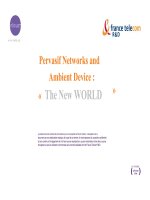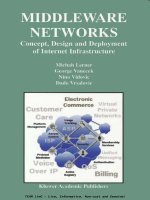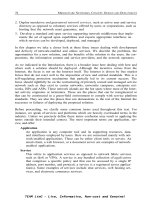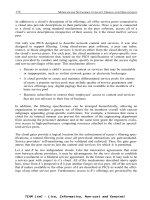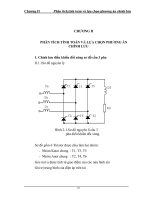Tài liệu MIDDLEWARE NETWORKS- P2 doc
Bạn đang xem bản rút gọn của tài liệu. Xem và tải ngay bản đầy đủ của tài liệu tại đây (732.47 KB, 50 trang )
This page intentionally left blank.
TEAM LinG - Live, Informative, Non-cost and Genuine!
Please purchase PDF Split-Merge on www.verypdf.com to remove this watermark.
C
HAPTER
2
Technology Overview
This chapter lays out the background needed to understand IP service platforms, and
in particular the synergistic technological developments that are transforming the
communications industries. The spectrum of the interrelated topics is very broad. We
view them from the unifying perspective of network middleware that spans the gamut
from the physical network fabric to the applications themselves. In this chapter we
focus on the key technologies needed by the IP service platform, and how these tech
-
nologies are directly impacted by such a platform. We also identify their significance
and relationships to other technologies. Beginning with developments in the circuit
-
switched networks that make up our telephone systems, we then explore their relation
-
ship to packet networks – such as the Internet – that carry our data in a multitude of
forms, and the services these networks offer. Coincident innovations in the software
industries extend the client and server technologies and thus imbue the Internet with
a dynamic and interactive presence. From this technological mosaic emerges the sub
-
strate for reliable systems enabling businesses and consumers through the 21
St
Cen
-
tury.
2.1 Public Switched Telephone Network (PSTN)
To most of us, the oldest and most pervasive communication network in the world is
the Public Switched Telephone Network (PSTN). This is the familiar global voice tele
-
phone network that provides telephone to anyone with a telephone and access rights.
Today, PSTN spans every country and territory in the world. Since the invention of the
telephone in the late 1800’s, PSTN has steadily grown out of the original Bell System
network developed by AT&T. In the U.S., it is made up of 196 geographical local access
and transport areas (LATAs) that are serviced by one or more Local Exchange Carriers
(LECs). Some of the well known LECs are GTE, Ameritech, NYNEX, Bell Atlantic, Bell
TEAM LinG - Live, Informative, Non-cost and Genuine!
Please purchase PDF Split-Merge on www.verypdf.com to remove this watermark.
28
M
IDDLEWARE
N
ETWORKS:
C
ONCEPT,
D
ESIGN AND
D
EPLOYMENT
South, and Southwestern Bell. Inter
-
LATA traffic is provided by the Interexchange Car
-
riers (IXCs). Examples of IXCs are AT&T, MCI WorldCom, Sprint, and Interliant. The
three
-
digit area codes are assigned to LECs within a given LATA.
This relationship between LATAs, LECs and IXCs is shown in Figure 2
-
1. Typical cus
-
tomers connect their premises equipment over a local loop to the LEC’s closest central
office (CO). The LEC connects its COs through a number of lines to its switching cen
-
ters, called tandem offices (TA).
The inter
-
LATA calls are switched to an IXC’s point of presence (POP) based on the
customer’s choice of long distance providers. Once the call leaves the LATA and enters
the IXC network, it may get switched through multiple provider’s networks based on
their peering arrangements.
Figure 2
-
1: The LATA view of PSTN
As part of “our” telephone network we may also think of wireless cell phones (see
Figure 2
-
2). This service is supported by a separate network using different technolo
-
gies from the wireline PSTN however, the two are closely peered and offer seamless
exchange of voice services. Unfortunately, there are several competing service stan
-
dards including different ones for analog and digital; these include the advanced
mobile phone service (AMPS) for analog, digital AMPS (D
-
AMPS), global system for
mobile communications (GSM), personal communications service (PCS), low
-
earth
orbiting satellites (LEO), specialized mobile radio (SMR), and cellular digital packet
data (CDPA). In the U.S., PCS is the dominant service with the large national PCS pro
-
viders being AT&T Wireless and Sprint PCS; most local Bells support their own cellu
-
TEAM LinG - Live, Informative, Non-cost and Genuine!
Please purchase PDF Split-Merge on www.verypdf.com to remove this watermark.
P
UBLIC
S
WITCHED
T
ELEPHONE
N
ETWORK (PSTN)
29
lar networks. A service that runs well on one of these standards or networks may be of
interest to the others as well; for example, the mobile “browser cell phone” merges
desirable features that originated in separate networks.
Figure 2
-
2: Connection Layers: Tower, MTSO Mobile Switch, PSTN Central Office
The PSTN is based on circuit
-
switching technology that establishes and maintains a
single end
-
to
-
end circuit for each call placed. The management of the calls requires the
support of three primary functions: switching, transmission, and signalling.
• Switching. This function handles automatic call routing by means of highly
sophisticated computers such as the 4ESS switching machines. A national net
-
work has on the order of 100 such switches strategically located in major hubs.
They were introduced in the mid
-
1970’s and continue to be upgraded with state
-
of
-
the art switching technology. Today, a single 4ESS switch can handle upwards
of 1.2 million calls per hour
Transmission. These facilities are responsible for physical transport of the call’s
information, in a manner that permits satisfactory recovery of the source signal.
The technologies include fiber
-
optic cables, microwaves, radio relays, and satel
-
lite communications. Most of today’s traffic is carried over Synchronous Optical
NETworks (SONET) and Dense Wave Division Multiplexing (DWDM) on fiber
-
optic cables. SONET operates at multiples of OC1(51.84 Mb/s) and the European
equivalent ITU
-
T SDH operating at OC3 and above
• Signalling. This function operates the out
-
of
-
band signalling which controls the
flow of calls across the network and supports the enhanced telephony services
such as toll
-
free calling including 800 service. We do not consider in
-
band sig
-
nalling
TEAM LinG - Live, Informative, Non-cost and Genuine!
Please purchase PDF Split-Merge on www.verypdf.com to remove this watermark.
30
M
IDDLEWARE
N
ETWORKS:
C
ONCEPT,
D
ESIGN AND
D
EPLOYMENT
2.1.1 Intelligent Network
The PSTN is actually composed of two networks. The first is the switched network that
carries the calls over circuits, and the second is data network that carries signalling.
This signalling network benefits greatly from reliable digital transport and processing.
They improve the efficiency of network management, while operating at much lower
cost. The signalling network also enables new and enhanced services. At the heart of
this network are the 4ESS switches and the SS7 protocol that form the modern Intelli
-
gent Network.
In the mid-1970s, AT&T developed Signalling System 6 (SS6) for the old Bell System to
automate calling
-
card validation, and remove the dependency on operators to handle
this validation. It was the first use of new computer
-
controlled switching functions on
an out
-
of
-
band secondary data network. The result was an all
-
in
-
one solution in which
each switch also performed basic call processing and database processing for both ser
-
vices and control. These solutions were typically built and deployed by different ven
-
dors who used different approaches to the provisioning and operation of the switches.
This required extensive and expensive coordination to synchronize and update both
the software and the database contents in the entire network. Nevertheless, this
enabled service providers to begin creating new services such as call forwarding. These
services were custom built from scratch and required extensive patching to integrate
into the existing systems.
As a side note, even with the later move to IN/AIN, this practice of building vertically
integrated systems continued until the early 1990s. In much the same way, the early
history of Internet services followed the same model. Yet in both industries, the tele
-
communication and the Internet models for building, provisioning, and operating ser
-
vices relied on a shared common infrastructure mainly out of economic necessity.
Ten years later, a faster and more capable Signalling System 7 (SS7) was developed as a
layered protocol with signalling links of 64Kbs. Today it supports 1.54 megabit signal
-
ling links. This established a global standard based on Common Channel Interoffice
Signalling architecture (CCIS), and was the beginning of the Intelligent Network (IN).
With the introduction of SS7, services moved out of the switches and into Service Con
-
trol Points (SCP).
The basic components of SS7 are the Signal Transfer Points, Service Control Points,
and Service Switching Points, as shown in Figure 2
-
3.
•
STP – Signal Transfer Point
STPs are signal transfer points which route queries between central office
switches and databases in SCPs. These are packet switches that forward SS7
messages from SSPs to SCPs based on the destination address of the SCPs.
TEAM LinG - Live, Informative, Non-cost and Genuine!
Please purchase PDF Split-Merge on www.verypdf.com to remove this watermark.
P
UBLIC
S
WITCHED
T
ELEPHONE
N
ETWORK (PSTN)
31
Figure 2
-
3: SS7 components of an IN/AIN
• SCP – Service Control Point
SCPs are the databases that hold the call routing instructions and the enhanced
services such as the network
-
based voice mail, or fax and IVR applications.
• SSP – Service Switching Point
SSPs enable central offices to initiate queries to databases and specialized com
-
puters.
The model for the Intelligent Network was realized when the services moved from
switches and into the SCPs, where these services could accept standardized messages.
This standardization concept was well understood in the software industry, but it was
not until the adaptation of SS7 and its common set of standardized messages that the
model entered the telephone networks. The standard message and the well specified
set of rules published by ITU
-
T and Bellcore created a very powerful platform on which
to build the next generation of telephony services.
2.1.2 Private Branch Exchange, Key Systems, and Centrex
Businesses using telephony services depend on the use of Private Branch Exchanges
(PBX), key systems, or Centrex systems; they support voice mail, service call centers,
speed dialing, redial, and other advanced voice services. All of these systems provide
connectivity between the members of the supported organization and the connectivity
to the PSTN. They differ in the location of the equipment and the ownership of that
equipment.
PBX and key systems are on
-
site privately owned systems. They differ mainly in the
size with PBX supporting large organizations while key systems tend to support small
businesses with only dozens of connections. Due to the large organizations supported
by PBX, PBX’s are connected to the central offices with T1 or PRI ISDN trunks. How
-
ever, the big difference between the two lies in the control of the local telephones. PBX
TEAM LinG - Live, Informative, Non-cost and Genuine!
Please purchase PDF Split-Merge on www.verypdf.com to remove this watermark.
32
MIDDLEWARE NETWORKS: CONCEPT, DESIGN AND DEPLOYMENT
grounds all calls and thus provides the dial tone to its organization. To call outside, an
outside access code has to tell the PBX to route the call outside. The PBX then has ded
-
icated trunk lines connecting it to a central office. With a key system, the dial tone is
provided by the central office.
Centrex, in contrast to a PBX or key system, is located in the central office of a tele
-
phone company; the term is derived from the words central and exchange. The motiva
-
tion for a Centrex was for a large company to outsource its PBX services to the
telephone company and save on the administrative and operational cost of managing
their own PBXs. The first Centrex system was deployed in 1965 in Newark, New Jersey
to support the Prudential Life Insurance Company. By 1982, according to a 1986
DataPro report, Centrex provided service to 70% of all business with over 1000 lines.
Since the divestiture of 1984, the legislation made Centrex more applicable to both
small and large businesses.
It is insightful to note that the Intelligent Network and the Centrex/PBX systems are
targeting the same requirements but from different sides of the spectrum. IN/AIN
offers telephone companies the infrastructure on which to build in
-
network services
focused primarily on home subscribers; while the latter offers local services and con
-
trol to organizations. As we explore next, the “new kid on the block (i.e., Internet)
offers these customers a captivating wealth of services common to both the PSTN and
data networks.
2.1.3 Services Spanning both the PSTN and the Internet
Since the early days of data networks, many ventures have tried to interoperate ser
-
vices in the PSTN and the data networks. These span a spectrum from controlling tele
-
phone
-
based devices and services from Internet hosts, up through running large data
and call centers in support of PSTN services. The results include Computer Telephony
Integration (CTI) with Telephony APIs (e.g., TAPI/JTAPI/TSAPI) on one end, and car
-
rier
-
class interoperability efforts such as TINA, Java AIN (JAIN), and Parlay API on the
other end. Several of these convergence technologies strive to decouple the upper
-
layer
services from the specific supporting technologies, and we describe several challenges
introduced through this realization.
CTI and Telephony APIs
Some of the key CTI applications include Integrated Voice Response (IVR),
predictive dialing, “faxback”, call center management, and IP telephony, To
address the growing demand by businesses to deploy CTI applications a
number of competing standards developed. These include Lucent’s Pas
-
sageways, IBM’S CallPath, SunXTL, Microsoft’s TAPI, Sun’s JTAPI, and Nov
-
ell/Lucent’s TSAPI. As an example, Microsoft’s TAPI integrates multimedia
stream control with legacy telephony and H.323 conferencing standard as
part of its Windows platform. TAPI solutions use their COM API to inte
-
grate a TAPI Server, interoperating with a PBX or a PC modem for PSTN
TEAM LinG - Live, Informative, Non-cost and Genuine!
Please purchase PDF Split-Merge on www.verypdf.com to remove this watermark.
P
UBLIC
S
WITCHED
T
ELEPHONE
N
ETWORK (PSTN)
33
access or ATM/ISDN NIC for WAN access, with an LDAP directory and
TAPI clients. TAPI uses RTP and RTCP for managing the synchronization
and timing of its isochronous (i.e., fixed duration between events or sig
-
nals) packets.
In October 1996, Sun developed Java Telephony API (JTAPI) in cooperation
with IBM, Intel, Lucent, Nortel, and Novell in an effort to offer a Java
-
based
open
-
specification for computer telephony standard. One of its goals was
to bridge the gap between numerous proprietary, competing standards for
CTI. With JTAPI, applications, regardless of the platform on which they
were developed, are able to interoperate with JTAPI
-
compliant compo
-
nents built with the other standards.
TINA (Telecommunication Information Network Architecture)
In 1993, the TINA Consortium (TINA
-
C) was formed with 40 leading Telcos
and software companies to cooperatively create a common architecture to
address the communication industry’s growing difficulty with the delivery
of new services, or adaptation to changes within the infrastructure. In 1997
TINA
-
C delivered a set of validated architectural specifications that inte
-
grated all management, development and control functions into a unified,
logical software architecture supported by a single distributed computing
platform, the Distributed Processing Environment (DPE). TINA’s DPE is
based on OMG technology, CORBA, and extends CORBA to provide func
-
tions specific to telecommunication.
TINA’s architecture is based on four principles, specifically:
• Object
-
oriented analysis and design
• Distribution
•
• Separation of concern
These principles address the telecommunication industry’s requirements
of interoperability, portability and reusability of software components, and
achieves valuable independence from specific technologies. Creation and
management of complex systems, formerly the burden of large vertically
integrated corporations, can now be shared among different business
stakeholders, such as consumers, service providers, and connectivity pro
-
viders.
Decoupling of software components, and
JAIN (Java APIs for Integrated Network)
JAIN is a set of Intelligent Network (IN) specific APIs developed by Sun
Microsystems for the Java platform. JAIN targets the integration of PSTN,
wireless, and IP networks, and specifically aims at some of the incompati
-
bility between IN programs that use SS7. The JAIN APIs define interfaces
for TCAP (SS7 database and switch interactions), ISUP (ISDN signalling)
TEAM LinG - Live, Informative, Non-cost and Genuine!
Please purchase PDF Split-Merge on www.verypdf.com to remove this watermark.
34
M
IDDLEWARE
N
ETWORKS:
C
ONCEPT,
D
ESIGN AND
D
EPLOYMENT
and MAP (cellular processing); its classes also support Operations Admin
-
istration and Maintenance (OA&M) and Media Gateway Controller Proto
-
col (MGCP). These capabilities parallel JAIN support for IP voice protocols
(H.323 and SIP). Together, they enable service development that is indepen
-
dent of the underlying communications stacks and implementations.
At its core, the JAIN architecture defines a software component library,
development tools, a service creation environment (SCE), and a carrier
-
grade service logic execution environment for building next
-
generation
services for integrated PSTN, packet and wireless networks.
Parlay API
In May 1998, an industry consortium was formed to develop an open API
standard that would allow 3rd party developers access to the Telcos’
switches and which would support new IP
-
based telephony services. The
consortium was spearheaded by British Telecom given the discussions
with the AT&T GeoPlex project, and now also includes DGM&S Telecom,
Microsoft, Nortel Networks, Siemens, Ericsson, Cisco and others. The Par
-
lay API being standardized by the consortium would facilitate the inter
-
networking of IP networks with the PSTN while maintaining its integrity,
performance and security.
Parlay’s philosophy closely parallels the approach taken in the GeoPlex
project at AT&T. Due to the close interoperation with PSTN, however, the
architecture does not subscribe to all the design principles described in
this book Specifically, it does not subscribe to the Routing Principle.
The Parlay API supports registration, security, discovery, event notifica
-
tion, QA&M, charging and billing, logging and auditing, load and fault
management, and offers service interfaces for services such as call control
and messaging.
Parlay
-
based applications are also intended to support TAPI
-
based appli
-
cations developed by enterprises.
JAIN and Parlay APIs are complimentary and together will provide significant oppor
-
tunities to expand the access and breadth of services available. Java provides the com
-
mon mechanism that makes Parlay services available on the Internet. Parlay is a way to
bring telecom models including security to the JAIN community, expanding the reach
of the JAIN activity
2.2 Packet Networks
This brings us to digital packet networks; these move data in small packets. Unlike the
switched networks that dedicate a single circuit to a single session, these move many
TEAM LinG - Live, Informative, Non-cost and Genuine!
Please purchase PDF Split-Merge on www.verypdf.com to remove this watermark.
P
ACKET
N
ETWORKS
35
packets from many sessions over the same circuit simultaneously, The previous span
-
ning services (Section 2.1.3) anticipated many of these interrelated developments.
Today with all the sophistication and complexity of the PSTN, many people perceive
the telephone and the data networks as being two completely different technologies
having little to do with each other. They perceive the use of modems to tunnel over
POTS between our computers and the Internet as shown in Figure 2
-
4; or perhaps
think of DSL or cable as offering direct broadband to the Internet through their ISP.
Figure 2
-
4 Tunneling to an ISP over POTS to reach the Internet
What many people do not realize is that parts of the PSTN have carried Internet traffic
since the very beginning of digital signalling, and this rising trend builds upon the
existing properties of the PSTN. Specifically: the underlying network technologies for
carrying voice and data are the same. Their respective transport networks are there
-
fore merging into one network. In some cases the all
-
digital voice circuits even bridge
the “last mile” into the subscriber’s business or home, thereby eliminating the remnant
analog portion from their local loops. In other cases the customers retain analog
equipment.
Due to the mix of premises technologies, the differences in this mix can be handled at
local switches and associated programs. These edge components distinguish between
analog and digital traffic. The ingress network adjusts to each kind of traffic, and for
PSTN service the source signals are transparent to the transport network. For example,
transmission impairments (i.e., noise) present different challenges to analog and data
signals.
The classic case is echo on a two
-
wire connection. Only analog devices – such as the
“black phone” – require echo cancellation to filter out the return signal inherent in the
sharing of one wire
-
pair by both end points. The networks’ echo canceller removes the
return signal that arrives after one round
-
trip delay time. Whereas echo cancellation
removes unwanted signals from analog voice, it must be disabled during digital trans
-
mission. Digital signals have different characteristics than analog ones. Modem
TEAM LinG - Live, Informative, Non-cost and Genuine!
Please purchase PDF Split-Merge on www.verypdf.com to remove this watermark.
36
M
IDDLEWARE
N
ETWORKS:
C
ONCEPT,
D
ESIGN AND
D
EPLOYMENT
devices actively maximize the useful bandwidth through signal
-
specific adjustments
adapting to various kinds of line
-
noise, including echo. The network’s echo
-
cancella
-
tion would drastically reduce the available digital bandwidth, and must be disabled
during digital traffic. Digital packet phones could make the echo cancellers completely
obsolete on all
-
digital loops, and thus eliminate the cost of these devices.
Another example of network convergence is in the use of T1 lines to simultaneously
carry data as part of the Internet, while also carrying voice. A PBX supports these mul
-
tiple traffic types over a single central
-
office connection. Network transports such as
T1, T3, ATM, Frame Relay, SONET and WDM subsequently carry the packets for both
PSTN voice and digital data. The transports can potentially be partitioned to carry
other media, including video or fax.
T1 is a common carrier for data packets and links many IP networks today, yet it was
developed by AT&T in the 1960s and deployed in 1983 specifically to save money on
outside cabling for telephony. T1 allows 24 channels over two pairs of copper, fiber, or
microwave media. Any one of the channels can carry either analog voice or data pack
-
ets. For data, that amounts to a DS
-
1 speed of 1.544 megabits per second arising from
the DS
-
0 speed of 64kb per channel. Similarly, T3 supports 672 channels, or a DS
-
3
speed of 44 megabits per second. The WAN that became the Internet was built largely
as a result of the existence of Tls serving the PSTN. Early in its deployment, channel
banks served the time
-
division muliplexing functions in connecting the T1 lines to
PBXs and central offices. It was at these channel banks that external data connections
could tap into the T1 lines along with audio lines from telephones and PBXs, and
apportion some or all of the 24 channels for data packets.
It was not long before T1 offered companies the solution for their long
-
distance com
-
munication needs for the multiple medias of both voice and data. Corporations could
lease private T1 or fractional T1 lines to interconnect their branch offices or to access
the Internet. Soon, however, its high cost created the need for a cheaper solution. The
result was the Frame Relay (FR). FR is a high
-
speed packet public network offered by
local and long distance telephone companies.
Companies that previously leased or owned costly private dedicated T1 lines of fixed
capacity, could instead rent circuits on an FR network. Inexpensive access lines con
-
nect the customer premise equipment (CPE) with the FR network. Depending on the
levels of desired service and cost, the FR circuits are either permanent virtual circuits
(PVC) or switched virtual circuits (SVC). PVCs are logical predefined paths through
the FR charged at a fured rate, while SVCs are temporary circuits charged per use. In
either case, the FR service offers a service level agreement (SLA) known as committed
information rate (CIR), or the minimum guaranteed throughput. These rates can be
guaranteed by the carrier given that they do not oversubscribe the capacity of the
frame relay. Neither PVCs nor SVCs can offer absolute guarantees on throughput or
Quality of Service (QoS).
TEAM LinG - Live, Informative, Non-cost and Genuine!
Please purchase PDF Split-Merge on www.verypdf.com to remove this watermark.
P
ACKET
N
ETWORKS
37
FR was, and continues as, the preferred method for connecting branch offices, particu
-
larly where time critical data is not an issue. This preference is under challenge by vir
-
tual private network (VPN) solutions with similar connectivity at lower cost. VPN
solutions may exploit multiple technologies and thereby obtain lower average delay for
a fixed traffic class.
In contrast to frame relay service which excels in interconnecting LANs and carrying
pure data traffic, network service providers now offer Asynchronous Transfer Mode
(ATM) as a high
-
speed switching service capable of carrying mixtures of voice and
video along with data traffic. ATM was developed by the telecom industry as a high
-
speed network technology specifically to carry isochronous streams (voice and video).
Fundamentally, ATM is a connection
-
oriented data link that carries small fured
-
sized
cells of 53 bytes arranged as a 48
-
byte payload and a five byte header. Instead of rout
-
ers, ATM networks establish virtual circuits (VC) and switch cells directly in hardware
according to the header. Virtual paths multiplex aggregated VCs through virtual path
connections (VPC) that define end points and QoS. The ATM standards define five
QoS classes and a variety of admission control algorithms ensure consistent perfor
-
mance.
At this point we should compare data with the isochronous traffic of voice and video.
From this discussion, it should become clear that some network services are better
suited for data and others for voice. To the hosts and applications that deal specifically
with one or more multimedia types, it may not matter exactly how the information
moves or over what types of network the information flows. They communicate every
-
thing over IP. It is the underlying network fabric that has to contend with the different
media requirements and here the differences are vast.
Consider real
-
time interactive voice and video applications [SEIF98]. These applica
-
tions are
• Sensitive to absolute delay (i.e., real
-
time)
• Sensitive to delay variance (i.e., isochronous)
• Tolerant of information loss (i.e., receiver interpolation), and
• Assume a priori knowledge of the communications requirements
The design of real
-
time interactive services must consider the human aspects of per
-
ception, especially since the underlying technologies may have unexpected effects on
the services. Human perception is extremely sensitive to short
-
term variations. This
occurs, for example, through subtle variations in signal delay giving rise to the phe
-
nomena of jitter.
This human sensitivity to artifacts – even the infinitesimal variations in ambient noise
– was crisply observed by an advanced student engaged in the programming of real
-
TEAM LinG - Live, Informative, Non-cost and Genuine!
Please purchase PDF Split-Merge on www.verypdf.com to remove this watermark.
38
M
IDDLEWARE
N
ETWORKS:
C
ONCEPT,
D
ESIGN AND
D
EPLOYMENT
time experiments at the Human Perceptual Research Laboratory of Purdue Univer
-
sity’s Department of Audiology. Informed subjects, typically students, were trained in
soundproof rooms to recognize minute, low
-
level signals produced by high
-
fidelity
computer
-
controlled audio equipment. These subjects indicated what they heard by
pressing the appropriate button on a console. Surprisingly, trained subjects demon
-
strated the ability to reliably detect the audio stimuli even with the volume set to zero!
Upon investigation it was determined that background noise included artifacts of the
computer
-
controlled switches. The subjects acquired a learned behavior that mea
-
sured artifacts beneath the threshold of their direct observation. Their perception was
better than the ambient noise. This lesson has not been lost on the communications
community, driven as it is by customer perception.
The public telephone system conforms to ITU standards for the minimum require
-
ments on voice quality to be acceptable; those standards stipulate the acceptable jitter,
delays, and thresholds that for the majority of the people are below their threshold of
perception. The standards recognize that a person’s perception system can interpolate
between drops in the signal and still be understood. That is why, for instance, we have
moving pictures; a sequence of images presented rapidly at a fixed rate.
Compare this to the requirements for data. A data exchange may proceed unfettered
with concern for small variations in the time scale, provided that content remains
flawless and the protocol can adapt to the timing variations (as IP does). Such trans
-
fers are:
• Insensitive to absolute delay
• Insensitive to delay variance (only when the last packet arrives is the data whole)
• Intolerant of information loss (even one lost packet may make the whole content
unusable), and
• Asymmetrical (data flows mostly in one direction, from the servers to the clients
and vice
-
versa)
Thus compare data traffic with voice traffic. Data is very sensitive to packet loss but
totally unaffected with delay and jitter, or the order of delivery. Voice traffic is, in every
respect, the opposite. ATM was designed specifically to address the requirements of
real
-
time interactive voice and video. Unlike data networks that tend to be connection
-
less, ATM is a connection
-
oriented network that guarantees performance characteris
-
tics of its virtual circuits and consequently is optimized for voice and collaborative
video. Although ATM has been described by some as the ultimate solution for inte
-
grated broadband communications networks [DEPR93], others feel that this is true
only in light of the limited bandwidth available today,
Throughout this book, we focus heavily and take advantage of the ubiquity of IP, but
for this discussion, a technology that is equally ubiquitous is the Ethernet [GIGAET].
TEAM LinG - Live, Informative, Non-cost and Genuine!
Please purchase PDF Split-Merge on www.verypdf.com to remove this watermark.
N
ETWORK
A
CCESS AND THE
L
OCAL
L
OOP
39
According to IDC, by 1997, more than 83 percent of all installed network connections
were Ethernet. This represents over 120 million interconnected PCs, workstations and
servers. The remaining network connections are a combination of Token Ring, Fiber
Distributed Data Interface (FDDI), ATM and other protocols. Unlike the higher cost of
the ATM and the higher complexity of mapping Ethernet frames to ATM cells, one
contender to ATM that avoids these disadvantages is the Gigabit Ethernet.
Gigabit Ethernet is a data link and physical layer technology that support capacities in
excess of 1Gb per second. It is an evolutionary technology from Ethernet that is simi
-
larly a connection
-
less, unacknowledged, variable
-
length packet delivery system. Cur
-
rently, the Ethernet running at 10Mb/s and Fast Ethernet running at 100Mb/s
dominate LANs; Gigabit Ethernet can offer seamless interconnection for the LANs in
the backbone. This dramatically reduces the cost of equipment and operations over
other heterogeneous solutions.
This brings us to the physical layer technologies in the WANs. A common signalling
method across optical
-
fiber links is SONET. SONET is commonly used by the carriers
to carry ATM, but it can also multiplex many different data link technologies simulta
-
neously. What SONET offers is the simultaneous transport of ATM, DS
-
1, DS
-
3, con
-
nection
-
less packet over SONET (POS), as well as all the others. This creates
opportunities to utilize the best
-
of
-
breed data
-
link technologies that are optimized for
given applications, and combine them to run over a transport backbone. This can sim
-
plify the end point view of networks through support of the ubiquitous Ethernet LANs
with end
-
to
-
end IP connectivity.
The best part of these new opportunities is the elimination of traffic bottlenecks,
which become mere artifacts imposed by slow multiples
-
of
-
64Kb backbone connec
-
tions. Today’s fiber optics form the technology for moving vast amounts of informa
-
tion, and the routing and switching technology has quickly moved from megabit, to
gigabit and now terabit capacities. A single switch that has a terabit capacity can move
a lot of information. Consider what a terabit channel (actually composed of 1000 giga
-
bit channels) can carry. One terabit capacity is equivalent to 300 years of daily newspa
-
pers sent in one second; the ability to stream 100 thousand television channels
simultaneously, carry 12 million telephone conversations or support 10 million Inter
-
net users browsing the web. Although OC
-
192 is being deployed today, OC
-
758 and OC
-
3072 are already on the horizon.
2.3 Network Access and the Local Loop
To the majority of users such as consumers, small business owners and public organi
-
zations that access the Internet, the innovation in the backbone is of distant concern.
Their online experience comes from the simple task of gaining access and maintaining
TEAM LinG - Live, Informative, Non-cost and Genuine!
Please purchase PDF Split-Merge on www.verypdf.com to remove this watermark.
40 M
IDDLEWARE
N
ETWORKS:
C
ONCEPT,
D
ESIGN AND
D
EPLOYMENT
an acceptable performance of their connections to the Internet through their ISPs or
enterprise LAN connections. For most of them, the promise of rich user
-
experience
with high
-
speed, 7 days by 24 hours (7 x 24 ) access using their LEC’s local loop has
lagged behind the state
-
of
-
the
-
art technology in the core networks. This has been due
primarily to the need to avoid incurring the high cost of upgrading the “last mile” local
loops from existing copper, twisted
-
pair wiring intended for analog signals. Yet, by late
1998, broadband
-
to
-
the
-
house services on wireless, DSL, and cable services began to be
widely offered.
Up until about 1998, consumer access to the Internet was provided by ISPs mostly
through dial
-
up modem access. A modem (short for MOdulator/DEModulator) con
-
verts a digital stream to an analog signal and vice
-
versa using the standard telephone
lines in the local loop and the PSTN in the backbone. The first analog modems oper
-
ated at only 110 baud (about ten characters per second), and the introduction of 300
baud modems (30 characters per second) was then viewed as a dramatic advance.
Today the consumer
-
market modems operate at a peak performance of 56kbps,
although their typical operational speed is slower due to the narrow effective band
available for the analog signal.
Faster technologies use existing wiring in a digital mode instead of an analog mode.
The first promising method was Basic Rate Interface (BRI) Integrated Services Digital
Network (ISDN) that uses two standard “copper pairs” providing two 64kbs channel
and one 16kbs signalling channel for a maximum throughput of 128kbs. This technol
-
ogy has not been widely accepted due to its difficulty to provision and install, as well as
the typical pay
-
per
-
minute charges. ISDN, much like the basic modem traffic, travels
through the telephone system and is an integral part of the circuit architecture. The
only physical differences are the local loop and the equipment at the central office. Due
to the digital signalling and aggregation of multiple copper pairs, the ISDN line sup
-
ports a wider range of services, transfers more data over the same LEC and IXC facili
-
ties, and is subject to different FCC tariffs than the analog voice line.
A more attractive class of service, Digital Subscriber Line (DSL), has recently emerged.
Unlike BRI ISDN, DSL’s relation to the telephone system is only in the local loop, and it
does not impose load upon the conventional circuits of the LEC or IXC transports. At
the central office, a DSL Access Multiplexer (DSLAM) forwards all traffic to the appro
-
priate ISP and bypasses the PSTN. DSL runs over standard Category 3 wiring, the basic
telephone lines up to and inside the house.
DSL utilizes the untapped bandwidth available in the telephone wiring of the local
loop. Audio voice traffic requires only a very narrow band (4k Hz) leaving ample fre
-
quency for data (typically 100k Hz). Thus POTS voice and the DSL data can move
simultaneously over the same wires without interference. The frequencies are sepa
-
rated at both ends of the local loop with splitters or DSL modems, as shown in
Figure 2
-
5.
TEAM LinG - Live, Informative, Non-cost and Genuine!
Please purchase PDF Split-Merge on www.verypdf.com to remove this watermark.
W
ORLD-
W
IDE
W
EB
41
There are several variations on the basic DSL service such as the Asymmetrical DSL
(ADSL), ADSL Lite, High bit rate DSL (HDSL), Consumer DSL (CDSL), and Very high
bit rate DSL (VDSL). These vary in basic service cost and speeds. DSL is very sensitive
to the length of the wires connecting the Central Office DSLAM and the DSL modems
at home. The actual rate obtained depends on the class of service and the distance. A
typical rate is 1.5 Mbps downstream and 512Kbps upstream. For a full ADSL, speeds
can be as high as 8 Mbps downstream and 1.5 Mbps upstream. Unlike cable which con
-
nects many users in the vicinity on a single shared segment of the cable, DSL provides
dedicated access.
Figure 2
-
5: Internet and POTS with Digital Subscriber Loop
The same notion of piggy
-
backing data over a medium carrying a signal for another
application is used with television coaxial cable. The main difference is that cable was
designed as a simplex broadcast medium while telephones were designed as separate
full
-
duplex circuits. With cable, the local
-
loop is one shared segment (basically a LAN)
that services a small neighborhood (as shown in Figure 2
-
6). The cable segment is ter
-
minated at the SOHO end by a splitter and at the cable office with a combiner that
merges the TV RF signal with the data signal from the Internet.
2.4 World
-
Wide Web
Before 1989, the non
-
commercial Internet that encompassed most universities and
research labs was the clubhouse of “techies” and academics. It was a simple but elegant
world of UNIX programming; information from other hosts was accessed through
command
-
line networking; each user knew all the wire
-
protocols and commands
needed to access the information on other machines using command shells for appli
-
cations such as TELNET, FTP, network news, and email. Commercial networked sys
-
tems were being deployed, but these were mostly large enterprise database solutions
accessing large computer mainframes deployed outside the labs and campuses.
TEAM LinG - Live, Informative, Non-cost and Genuine!
Please purchase PDF Split-Merge on www.verypdf.com to remove this watermark.
42
M
IDDLEWARE
N
ETWORKS:
C
ONCEPT,
D
ESIGN AND
D
EPLOYMENT
Figure 2
-
6: Internet and Television access over Cable
Even so, much activity centered around posting large collections of information online
(see Figure 2
-
7). Network news was a highly popular means of publicly exchanging
information; Gopher, the precursor to WWW was quickly gaining university and gov
-
ernment support for distributing information; Veronica and Jughead, served as the
Gopher search supports; Archie (derived from the word archive) was an effort to
archive the content of FTP sites using several Archie servers; the Wide
-
Area Informa
-
tion Server (WAIS) offered detailed document indices allowing keyword searches
through the archived documents. Gopher was a hierarchical menu
-
based system con
-
sisting of thousands of Gopher servers; it demonstrated the model for what the WWW
would later generalize and improve upon. Archie was the model for how modern
search engines and robots on the Web collect information, and WAIS and Veronica
were the models for how they can be searched.
In the mid 1980’s, a scientist in a wide range of disciplines began to collaborate over the
Internet and to exchange information and access networked resources in geographi
-
cally disparate locations. To a non
-
computer scientist or an engineer this was both an
asset and a limitation. It was an asset because scientist in different continents could
share information easily and quickly; a limitation because everyone needed to learn
how to program and understand low
-
level networking.
As with most great innovations, the time was “right” to address this problem by com
-
bining several technologies: the Internet, the client
-
server model, hypertext authoring,
multimedia mail specification, and scheme of universal resource addressing. Formerly
intimidating technologies suddenly became simple and widely accessible. Tim Bern
-
ers
-
Lee put these elements together in 1989 at the European laboratory for Particle
Physics (CERN) creating the basic architecture we now call the World Wide Web
(WWW). At that time, email was taking on additional media capabilities through the
support of Multipurpose Internet Mail Extensions (MIME) for description of
TEAM LinG - Live, Informative, Non-cost and Genuine!
Please purchase PDF Split-Merge on www.verypdf.com to remove this watermark.
W
ORLD-
W
IDE
W
EB
43
Figure 2
-
7: On the Road to the World
-
Wide Web
attributes of the content in SMTP, as well as encapsulation of multibody, multimedia
content. At the same time, a hypertext technology was being standardized around
SGML. Tim merged the two into a new protocol called the Hypertext Transfer Protocol
(HTTP) that utilized MIME and a newly designed document type definition (DTD) of
SGML called Hypertext Markup Language (HTML). These innovations were used to
create the web as a collection of HTTP servers that individually formed portals into the
local servers’ information bases. Almost immediately, the physicists at CERN could
offer their multimedia information without requiring the direct use of FTP or TELNET.
With the HTTP servers, the burden of the ease
-
of
-
access was shifted to the software
clients accessing the web. Initially simple text
-
based clients were created to resolve the
new Universal Resource Locators (URLs), retrieve the resource, and either store it
locally or render it using a collection of existing applications. Almost immediately, the
notion of a browser was formed. A browser was to be an GUI application that could
render most of the standard multimedia formats: text, image, and sound. The browser
would abstract even the higher level client
-
server details of the WWW from the user
and offer a simple visual window based point
-
and
-
click interface to the information on
the web.
Although Tim’s WWW foundation was the single most important enabling factor for
the industry, the catalyst that ignited the popularity of WWW happened at the
TEAM LinG - Live, Informative, Non-cost and Genuine!
Please purchase PDF Split-Merge on www.verypdf.com to remove this watermark.
44
M
IDDLEWARE
N
ETWORKS:
C
ONCEPT,
D
ESIGN AND
D
EPLOYMENT
National Center for Supercomputing Applications (NCSA) at the University of Illinois.
There, graduate students developed a graphical browser called Mosaic. Mosaic was a
government sponsored project to create a standards
-
based browser for the WWW.
One of those students was Mark Andreessen, who directed the Mosaic team and later
co
-
founded Netscape Communications Inc. Mosaic demonstrated the potential of the
WWW and helped launch the wildly popular Internet we know today.
Figure 2
-
8: WWW Connectivity
Around that time, work resumed on extending the role of the servers, which then
offered primarily static information stored on local disks. The first step was develop
-
ment of the Common
-
Gateway Interface (CGI) allowing HTTP requests to invoke
external programs. These programs could deliver individualized content through
interpretive shell scripts, Perl or TCL language programs. Currently, CGI programs are
being replaced by Java servelets or server
-
side scripting languages such as Personal
Home Page (PHP) and JavaScript. These are designed to dynamically generated pages.
PHP is a particularly elegant solution in the form of a scripted language embedded in
HTML and executed by the server as the HTML is relayed to the browser. PHP’s stron
-
gest value is generation of database
-
enabled dynamic web pages, a role that it achieves
easily and quickly through activates of diverse databases. This leverages vast informa
-
tion assets stored in dBase, FilePro, Informix, InterBase, mSQL, Oracle, Sybase, UNIX
dbm and other repositories. It also supports interfaces to other services using proto
-
TEAM LinG - Live, Informative, Non-cost and Genuine!
Please purchase PDF Split-Merge on www.verypdf.com to remove this watermark.
W
ORLD-
W
IDE
W
EB
45
cols such as IMAP, SNMP, NNTP, POP3 and HTTP In general, server
-
side scripting lan
-
guages have changed the nature of the web; what used to be a domain of mostly static
pages is now predominantly the domain of up
-
to
-
date, dynamic pages that integrate
multiple sources and formats.
The original deployment of CGI led to the more general notion of generality and exten
-
sibility of the browsers themselves, leading to the notion of browser plug
-
ins. Third
party developers crafted browser
-
oriented services delivering complex information
through a collage of content
-
oriented formats including device independent Portable
Document Format (PDF), macromedia, and Virtual Reality Markup Language (VRML).
This soon transformed into a general notion of dynamically varying presentations
through browser
-
resident programs, automatically downloaded through new scripting
languages such as JavaScript. The unprecedented levels of dynamic interactions drove
the browser from its stateless situation, and arrived at persistent browser
-
specific
information.
To create scalable browsers with stable information and yet preserve subscriber pri
-
vacy, the notion of cookies was developed. In computer jargon, a cookie encapsulates
arbitrary name/value pairs. Servers can create cookies, and browsers selectively store
such cookies locally upon receipt. The browsers return the right cookie on subsequent
visits. This way a service offered via the server can store the state in the client (see Sec
-
tion 6.7.1).
Today, the notion of rendering HTML is being generalized to multiple translations per
-
formed by both the server and the browsers with HTML serving a very narrow function
as the final presentation format. This involves information represented in the Extensi
-
ble Markup Language (XML) suitably transformed to HTML according to rules
described with extensible Style sheet Language (XSL). The browser presents the
HTML through locally
-
stored presentation styles described by Cascading Style Sheets
(CSS).
The proliferating WWW technologies hastened ongoing developments centered
around security and privacy. Almost immediately, HTTP could be made to communi
-
cate authentication and access control attributes that the servers verified and imple
-
mented. This initiated a shift of the public WWW into subscription
-
based private
subgroups with restriction of information to authorized users. To ensure information
privacy, public
-
key encryption technology was incorporated into the client and servers
thereby providing cryptographically
-
secured data streams, known as crypto
-
tunnels,
between the servers and the browsers. Strong market
-
driven concerns for interopera
-
bility – the choice to use any browser or server – impelled the universal acceptance of
Secure Socket Layer (SSL) technology which is a de facto standard of WWW privacy
The web servers are no longer the sole sources of Web information. Proxies, which sim
-
ply put, are HTTP relays with value
-
added functions, quickly became an integral part
TEAM LinG - Live, Informative, Non-cost and Genuine!
Please purchase PDF Split-Merge on www.verypdf.com to remove this watermark.
